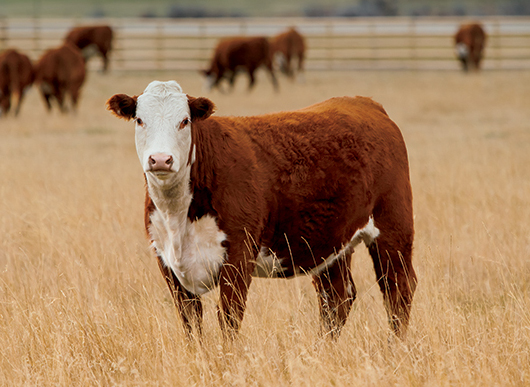Home > Montana > Montana Farm to Table > A Legacy in Beef
A Legacy in Beef

Picking up where his grandparents left off nearly 30 years ago, Jack Holden has kept a straight line in the Holden Herefords ranch he runs in Valier. His grandfather, Les Holden, bought his first Line One bull in 1947, and Jack Holden continued line breeding the Herefords after he took over the operation in 1987 at the age of 21. Just as they did in his grandfather’s days, Holden’s cattle maintain top-quality genetics.
“I grew up working with my grandpa,” says Holden, who runs the ranch with his wife, Tresha, and son and daughter. “I was blessed to be able to come in and take this over. Our cattle are one line of Hereford cattle called Line One. The line breeding is what gives our program consistency, predictability and uniformity. We’ve had years of doing things right.”
Though it doesn’t have quite the history of Holden Herefords, the Mytty Angus Ranch in Florence also takes pride in its performance cattle that come from elite and power-packed cow families.
![Montana Beef [INFOGRAPHIC]](https://eadn-wc01-4177395.nxedge.io/wp-content/uploads/2020/05/Screen-Shot-2015-03-11-at-10.46.02-AM.png)
Kevin Mytty says his operation strives to focus first on fertility and then zeroes in on “structural soundness and phenotypical cattle that will consistently deliver calves with powerful weaning weights and yearling weights.
“We continue to make great strides in performance, feed efficiency and gain ability in our customers’ calves in feed yards across the country.”
Mytty followed in the footsteps of his father, who had a commercial Hereford herd, before starting an Angus herd in 1998.
“Basically, we started off with about 20 registered cows,” Mytty says. “Then we bought about 100 cows around 2001. From then on, we’ve grown our own herd.”
Mytty also has an embryo transfer program in Grass Range, where he typically harvests embryos from 10 of his top 5-year-olds each year. In addition, the Mytty Angus Ranch develops between 500 and 600 commercial heifers that stem from its best genetic base, and breeds them with the most proven bulls in the breed for calving ease.

Uruguay’s Strong Potential
To help strengthen Montana’s beef genetics, Holden and Mytty were eager to accompany Marty Earnheart, the Montana Department of Agriculture’s Meats and Livestock marketing officer, on a trade mission to Uruguay in the fall of 2014. The South American country has a strong cattle market that has experienced considerable growth in the past five years.
The group visited 10 farms and met with 16 different producers. All were purebred herds, both Hereford and Angus.
“We hope to increase sales to Uruguay,” Earnheart says. “In the past, we’ve had some sales, but with their ability now to ship beef to countries like China, Russia and others in the region, and their exports poised to increase quite a lot, we hope to back-sell what they’re shipping out.”
![Beef Breed [INFOGRAPHIC]](https://eadn-wc01-4177395.nxedge.io/wp-content/uploads/2020/05/Screen-Shot-2015-03-11-at-11.11.39-AM.png)
“They’re losing a lot of cattle land to farming and to crops, so they need to have a bigger, more efficient cow on less land. They’re looking to Montana genetics to do that for them,” says Earnheart.
Holden, who has exported frozen breeding material to Australia for nearly 30 years and ships embryos to Scotland, England, Canada and Uruguay, says the trip was beneficial.
“Uruguay’s market is strong, compared to other countries in South America,” he says. “They’re very progressive breeders with no health issues. There is quite a bit of export opportunity.”
Earnheart traveled to Costa Rica later in the year to develop a cross-breeding project.
“That’s a small market for now,” she says, “but it’s one we hope can grow and become a steady market for Montana.”




